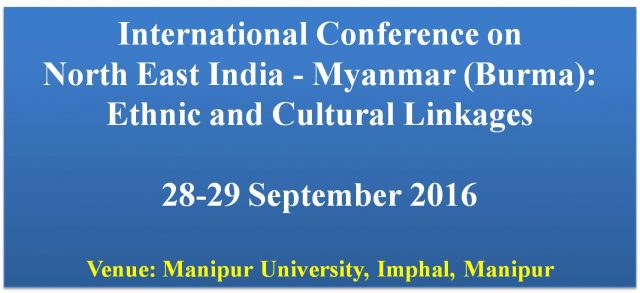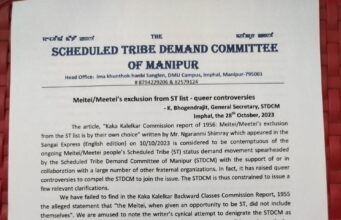Venue: Manipur University, Imphal, Manipur, Date: 28-29 September 2016
Indira Gandhi National Centre for the Arts, New Delhi in collaboration with Manipur University, Imphal, proposes to hold an International Conference on “North East India and Myanmar (Burma) : Ethnic and Cultural Linkages” at Manipur University, Imphal, Manipur. The people of North East India and Myanmar have broadly similar Indo-Mongoloid/ Tibeto Burmese physical features while their languages belong to the Tai and proto-Australoid speech family. Majority of the people in North East India are tribal and each of the tribes are marked by their– distinct cultural traits i.e. language, festivals, customs, dances, arts, folklores, traditions, beliefs system etc.
Geo-topographically North East India and Myanmar fall in the same geographical zone and are connected by land routes since ancient times. Myanmar, a gateway to South East Asian countries, shares a border of 1640 kilometres with North East Indian states. Being a neighbour, Myanmar played a significant role in the spread of Indian Culture, trade, commerce, philosophy, custom, religious practices and belief system through land to South East Asian Countries. North
Eastern States of India and Myanmar had strong people-to-people contacts since ancient times and therefore had a lot of ethnic and cultural linkages.
A number of archaeological excavations carried on across the North Eastern region yielded a large amount of polished Neolithic tools and these have great affinities with the South East Asian tools including Myanmar. The use of shouldered axes and also cord-impressed pottery can be taken as examples. The Neolithic links between Myanmar and North East India can be dated between 2500-1500 BC. The important sites of the region are Daojali, Hading and Sarutaru in Assam; Napchik in Manipur and Pynthorlanlgte in Meghalaya. .
The early settlers of Myanmar were Tibeto-Burman speakers like the Pyus and the Mons of the Upper Burma and the Lower Burma respectively. In the 9th century, the Bamar entered the upper Irrawaddy valley and by mid – eleventh century founded Pagan kingdom leading to the development of the Burmese language, culture and the Theravada Buddhist tradition. The Pagan ceased its existence after the Mongol invasions. This resulted into emergence of several warring states. During 16th century, a reunified Taungoo Dynasty emerged in Myanmar.
There have been movements of ethnic people from India to Myanmar and vice versa since ancient times. The Singphos and the Tai groups such as the Ahoms, Khamtis, Phakes. Aitons, Turungs and the Khamyangs moved to North East India from Shan state of Yunnan and Myanmar. In the same way Nagas, Kukis, Mizos, and the Lushais entered North East India from Burma. The people collectively known as Chins by the Burmese live along the border of North East India and Myanmar. Similarly, there are still a good number of Nagas tribes inhabiting western Myanmar adjacent to the Indian state of Nagaland. It is believed that the Khasi people also migrated to India from Myanmar. All these people still maintain their language, traditions, arts, crafts, life style as well as traditional religious practices. Thus there have been constant cultural relations between North East India and Myanmar.
The Burmese produced significant Hindu and Buddhist temples besides sculptures of both Hindu and Buddhist deities. A large number of them which are still preserved reveal Gupta and Post- Gupta styles submerged by indigenous art idioms. The textiles of the people of North East India and Myanmar are of various designs and colours decorated with glass, bird motive, feather and cowries. Red coloured cloth symbolises for bravery. Another prominent colours frequently used are black as a background or in combination with other colours such as green, orange, yellow and blue. The textiles designs are very intricate showing human and animal figures.
The Burmese are fond of Musical instruments. The musical instruments of Myanmar can be classified into 1. drums of various kinds: the one headed drum, pot drum, two headed drum, big drum, short drum, horizontal sitou, bjo and rattle; 2. Bells of different kinds: jingle bell, bane bell, hallow bell, cymbal, mellifluous bell, timing bell: 3. Rods of different types : iron rod, brass rod, rod made of wooden block and stone rod: and 4. Conch shell 5. Hollow bamboo; 6.Hne; and 7. Flute trumpet. Similar types of musical instruments are very commonly used in the North Eastern part of India.
Early Burmese literature was influenced by Indian epics such as the Ramayana which have various versions in the South East Asian countries. The Myanmar literature were primarily of a religious nature and a good number of them were found inscribed on stones. These inscriptions are traced back mostly to the Pagan period of the 11th century AD. During Pagan period, King Aniruddha adopted Theravada Buddhism as state religion and brought many Pali texts from Ceylon. These texts were translated in Pali and Pali remained the literary medium of the Burmese kingdoms. Palm-leaf manuscripts and folded paper manuscripts came into existence only after the 15th century. The literatures of that period were mainly concerned with the Jataka tales as told by the Buddha to his disciples in answer to certain questions.
The British conquered Myanmar after the third Anglo-Burmese war. 1885. During the period of colonial rule, Burma and North East India had strong people-to-people contacts. As a result groups of people from Manipur and other parts of North East India migrated and settled in Burma. A Tamil community, part of an over 400,000-strong Indian-origin population, is still based in Myanmar. Myanmar played a significant role in Indian Independence movement. The country became independent from the British rule in 1948.
Several measures have been undertaken under the aegis of the “Look-Act East” policy to deepen the linkages between North East India, Myanmar and South East Asia. First amongst these measures has been a proposal to build the “Asian Highway”, “Asian Railway Link” and “Natural Gas” pipeline. The proposed geographical niche for the Asian Highway is the Imphal (India) – Tamu (Myanmar) road going on to Kalemyo railway and further to Mandalay in Myanmar. A four lane Asian Highway is also sought to be constructed between New Delhi-Singapore via Kuala Lumpur, Ho Chi Minh City, Phnom Penh, Bangkok, Vientiane, Yangon, Mandalay, Kalemyo, Tamu, Dhaka, and Kolkata. Road construction has already been started from Tamu to Kalemyo (Myanmar). There is also a plan for construction of a 1,360 km. Trilateral Highway from Moreh (India) to Mae Sot (Thailand) through Pagan (Myanmar). Moreh in Manipur is seen as the key to India’s “Look-Act East” policy and the construction of an International trading and cultural centre has already been completed. There has been a consistent demand for reopening of the Stilwell Road built during the period of World War II. The road passed through the Patkai Hill range and goes to Yunnan via Myitchina. The Tai peoples and the Singphos entered North East India by an old route that linked Assam with Burma.
The proposed International Conference shall focus on the following sub-themes:
- Prehistoric and historical inter-cultural linkages
- North East India and Myanmar Ethnic commonality.
- Connections o` art and Architecture with North Fast India and Myanmar
- Religious linkages with special reference to Hinduism, Buddhism and other Religious Traditions
- Inter-cultural connections in textiles.
- Musical Instruments
- Pali based literature and epigraphy.
- Colonial Burma












